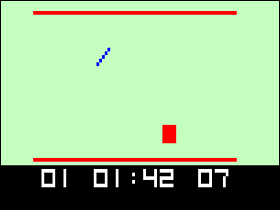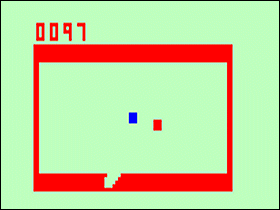Tennis / Hockey
 The Game: Activated by leaving a cartridge out of the slot, powering the system up and pressing one of the selector keys, Tennis and Hockey are built into the system. Timed games can be selected, and the traditional rules of each sport apply. (Fairchild, 1976)
The Game: Activated by leaving a cartridge out of the slot, powering the system up and pressing one of the selector keys, Tennis and Hockey are built into the system. Timed games can be selected, and the traditional rules of each sport apply. (Fairchild, 1976)
Memories: An interesting indicator of how new the idea of interchangeable cartridges were, Channel F featured two built-in games as well. If a Channel F owner bought the machine but never bothered with any of the game cartridges, he could still enjoy the console. It’s really no surprise, then, that Fairchild fell back on some standard-issue video game ideas – nothing obscure for Channel F’s built-in games. [read more]

 The Game: The first Channel F “Videocart” packs three games into one bright yellow package. Shooting Gallery is a straightforward target practice game in which players try to draw a bead on a moving target. Tic-Tac-Toe is the timeless game of strategy in small, enclosed spaces, and Quadradoodle is a simple paint program, long, long before its time. (Fairchild, 1976)
The Game: The first Channel F “Videocart” packs three games into one bright yellow package. Shooting Gallery is a straightforward target practice game in which players try to draw a bead on a moving target. Tic-Tac-Toe is the timeless game of strategy in small, enclosed spaces, and Quadradoodle is a simple paint program, long, long before its time. (Fairchild, 1976) The Game: Trapped in a square or rectangular arena, the player is represented by a mobile square. Another projectile punches its way into the arena and begins ricocheting around; points accumulate rapidly the longer the player’s square avoids contact with the projectile, but starting at 200 points, an additional projectile is added every 100 points, each on its own chaotic, bouncing path. The game ends when the player inevitably collides with one of these projectiles. (Fairchild, 1978)
The Game: Trapped in a square or rectangular arena, the player is represented by a mobile square. Another projectile punches its way into the arena and begins ricocheting around; points accumulate rapidly the longer the player’s square avoids contact with the projectile, but starting at 200 points, an additional projectile is added every 100 points, each on its own chaotic, bouncing path. The game ends when the player inevitably collides with one of these projectiles. (Fairchild, 1978)